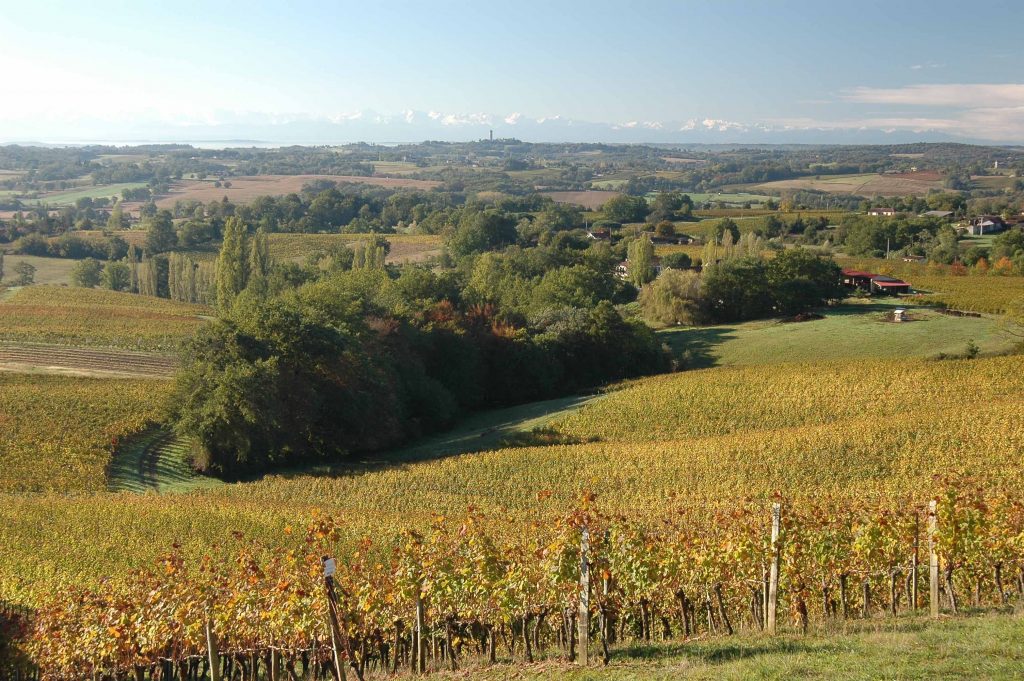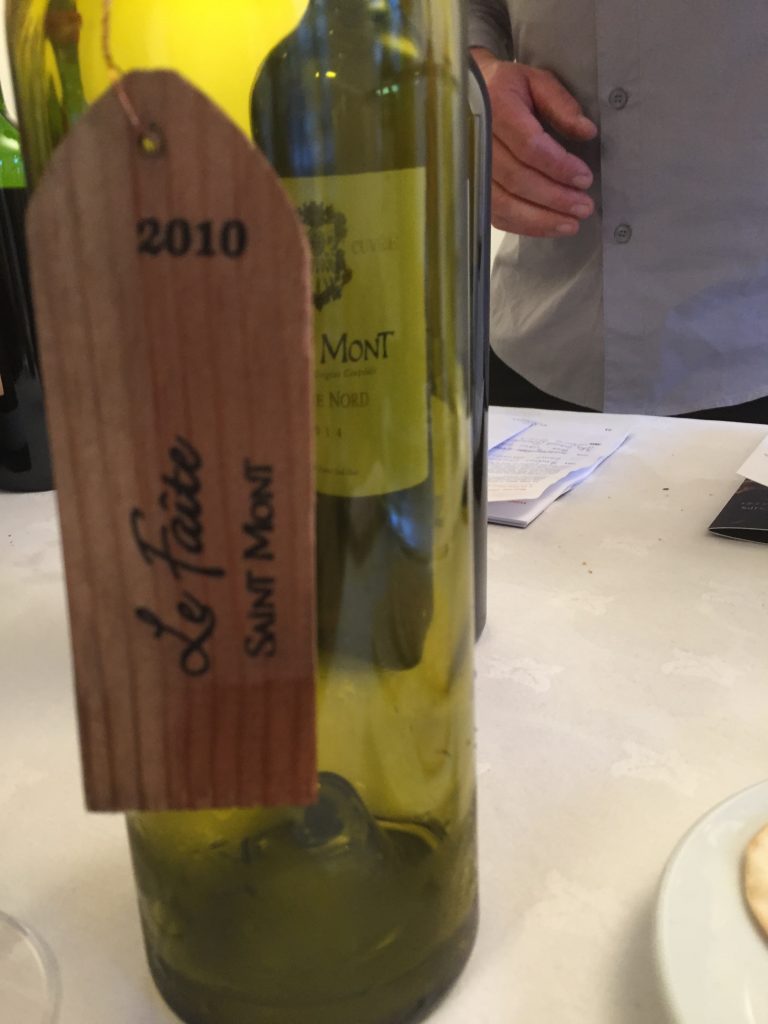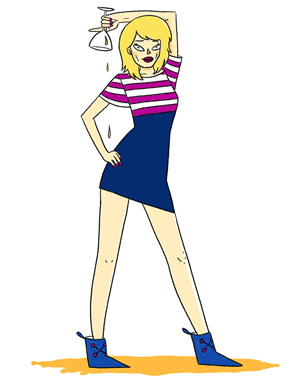
A mere 23 grapes make up 91% of the vineyards of France. I am quite prepared to believe this nugget of information that came my way, just don’t quote me. It’s a pity as there are plenty more which have fallen by the wayside for one reason or another – too unproductive, overly sensitive to some malady, maybe just not that nice in their own company. But as climate changes and wine consumers expectations evolve, there is a growing demand for something other than the obvious.
In the blog for May, the Nose was in south West France inhaling the peppery aroma of some long lost red varieties. This time I am on the scent of the native white varieties.
This neck of the woods is one of the few places in the world where you can find Vitis vinifera subspecius sylvestris aka the wild vine – climbing through trees as they did 2000 years ago. They survived phylloxera because of the sandy soil. They have tiny berries with huge seeds given the plant was focused on reproducing, on spreading their seeds with the help of birds.
The very first vines were red and are male or female. When we cultivated the grape vine to make wine, we selected hermaphrodites as they are self pollinating, which makes sense. The ampelographers here have identified some interesting female vines. Trouble is they need a male vine for pollination and as such it is illegal to grow them commercially in France. The law was designed to ensure good production, but as the pendulum swings from quantity to quality, some of these interesting girls might get a look in.
But for now there are four principal white varieties grown in the foothills of the Pyrenees; Gros Manseng, Petit Manseng, Petit Courbu and Arrufiac. The region has a wet spring and a hot, long summer…. and long ago the sea receded to leave the regions sandy soils, which overlay the clay.
So what do these grapes taste like? It’s not easy to know as the varieties are typically blended. However the Plaimont Producteurs put on a tasting in London of the individual varieties and having tasted we were encouraged to have a shot at making them into a blend.
The samples (from the 2017 vintage) were destined to become a wine called Les Vignes Retrouvées. There are only 1250 hectares planted with these grapes across the region and some of the best parcels are selected for this blend.
The fruit is harvested in end of September at night to bring the fruit in cool. The samples had not gone through a malolactic fermentation, (nor will they) so they have a strong malic character… think green apple and tart acidity. The grapes were gently pressed and fermented at 18-20 in stainless steel, before being aged for 6-8 months on fine lees in tank.
First up Gros Manseng: The aromatics are herbaceous and strongly reminiscent of grapefruit. The narrow palate has notes of green pea and lime. There is a shed load of malic acidity. It had 6-8 hours skin contact which should reduce the level of malic acidity, but not a lot it would seem. It has a little tannin and the finish is quite salty. Interesting, but not something I’d fancy drinking on its own.
Next up Petit Courbu: This has a spicy, rather exotic character with notes of apricot mixing with some greener notes from the malic acidity. It has much less acidity, but is not too soft. It has a good mid palate. It’s lightly rounded and I can see this becoming creamier. There is an alluring floral finish. It’s an aromatic wine for sure. Petit Courbu is not an easy grape to cultivate. The yields are low and erratic and it is very sensitive to botrytis.
Last but not least Arrufiac: Not much on the nose. Much less aromatic. Tight on the palate, it is leaner and lighter-weight than Petit Courbu. The pithy finish is the most notable feature. Both ‘pithy’ and ‘pith’ as in a bitter note – but it’s a good bitter character. This is another tricky one to cultivate. Yields can be very high and it needs green harvesting. It has lower alcohol potential – this sample was 11.5 and the harvesting can continue into October.
And what about the ideal blend? Well you have to start with 50% Gros Manseng as that’s the legal minimum. I tried out a few combos – 25% Arrufiac was undrinkable, but I did like 50% Gros Manseng and 35% Petit Courbu rounded off with 15% Arrufiac.
Oenologist Christine Cabri considers this is too much Petit Courbu and will use 60% Gros Manseng, 20% Petit Courbu and 15% Arrufiac. “This a better blend for the long term,” she says, “You need a lot of acidity to age the wine.” Its fun blending wine. I did it as a buyer years ago. It depends on your market and the drinking window. The aromatics of Petit Courbu are instantly appealing and make a blend more accessible. You need acidity to age, but you also need some fat. Christine is the expert in these varieties and knows how they travel.
Les Vignes Retrouvée 2016 (ratio 75/20/5) is very primary, grapefruity, zesty and vibrant.
Les Vignes Retrouvée 2015 (ratio 75/22/3) shows some engaging honeyed exotic notes. It has light fullness to the palate and is fresh and nicely balanced with an aromatic finish.
Les Vignes Retrouvée 2007 (ratio 70/30) This is a mature wine with honey and truffle notes. Lovely and mellow and quite fresh on the finish.
This wine is sold to the on trade, so hopefully you might find it on a restaurant wine list.
I cannot write this piece without including Le Faite Blanc. This white is a blend of Gros Manseng, Petit Manseng and Petit Corbu with a seasoning of Arrufiac. This intriguing wine is available off trade for approx £17-20.
It is described as coming from the most expressive terroir of Aignan, Plaisance and Saint Mont. The best old vine parcels in cooler micro-climates are selected. It is harvested at night and the Gros and Petit Manseng receives prolonged skin contact (8-12 hours).
The nose was not given a chance to taste Petit Manseng flying solo, which is a pity. It is one of the oldest grapes in cultivation as it can be traced back 1000 years. It needs a lot of rain, which it gets here in the spring, but I’m told it could probably do with more to be a single varietal and works well in a blend here. It is good as late harvest sweet style for it can reach a potential 16 degrees, but for a stand alone dry wine this means it can become too big and rich. (On the other side of the Pyrenees, where they get more rain, it is more successful vinified alone).
So what about the wine.

Le Faite Blanc 2014
This has a wonderful honeyed aroma with orange flower and passionfruit. The medium bodied palate is fresh and almondy with some apricot notes balanced by citrus freshness. There is a bit of tannic grip and a fresh salty finish. Yum, yum.
This is another white wine designed to mature. The 2010 had not evolved much and showed very little more maturity than the 2014.
This focus on wine to age and white wine to boot is curious. Curious for region with no tradition of ageing wine to drink at home. The locals have no cellars – this may be something to do with the sandy soil. It was always rare to put aside a bottle to age and only to mark a special occasions – a wedding or a birth – might a particular vintage be stored, to be unearthed at a later date. And it would literally be ‘unearthed’ as the bottle was dug into the soil to be stored. A paper label would rot of course. Hence the tradition of a wooden tag evolved (see below).
Well this is a region that wants to be different and it is. I’ve enjoyed these unusual whites and look forward to sniffing new blends of old varieties in years to come.
I might even be temped to store a few bottles in the flowerbeds.

